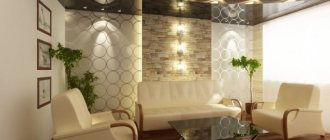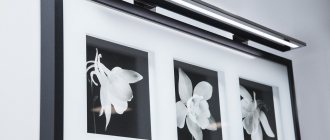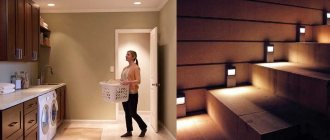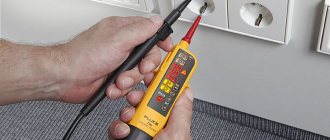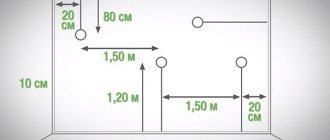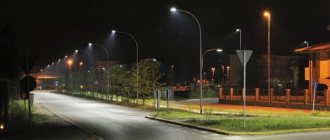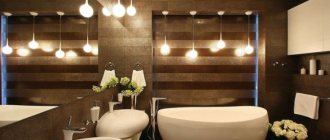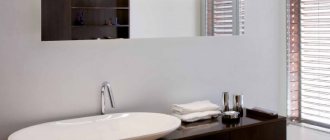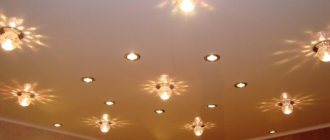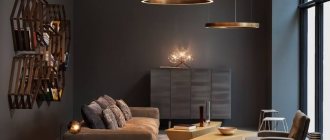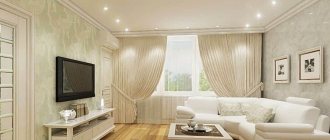The quartblog will explore the issue of lighting in the bathroom, where and how to place lamps correctly, and what types of lamps are suitable.
The problem of bathroom lighting receives undeservedly little attention. While chandeliers, floor lamps and table lamps are being selected for months for living rooms, bedrooms and even kitchens, the bathroom, in a sense, remains terra incognita. Most homeowners believe that the minimum required to illuminate a bathroom is one simple source.
But let's think about whether this is so. In all other rooms, there are supposed to be more light sources, and they are each dispersed in their own area. Thus, all parts of the room are equally illuminated, and you can use all the possibilities at once or separately.
No one will argue that the desk and chair in which we are used to reading in the evenings need additional lighting - a chandelier, naturally, cannot cover all areas. And it’s even more surprising that for some reason different standards apply to the bathroom.
Bathroom lighting: highlights
Someone might argue that a standard bathroom is smaller in size than the average room, but even then the lack of light can only aggravate the situation: a darkened room will look more like a closet.
The motto of light sources in the bathroom is simplicity and practicality . That is why the most popular solution to the problem here is to install spot lighting . This kind of lamps looks quite modest and almost invisible, easily fitting into a modern interior.
Lighting in the bathroom should not be bright and intrusive. At the same time, with insufficient lighting and poor organization of the lighting scheme, you will not be able to properly relax and enjoy the bath procedures.
You can avoid this by knowing how to correctly position the lamps in the bathroom, which lighting device is best to choose and the features of room lighting depending on the type of ceiling.
But let's talk about everything in more detail.
Bathroom lighting diagram
The overall impression your bathroom will make largely depends on the location of the light sources. Therefore, the lighting scheme for this room should become one of the components of the overall design of the project, even if we are talking about a tiny bathroom space in an ordinary Khrushchev-era building.
What can we say about modern new buildings, the rooms in which are spacious and have an original layout. There is plenty of room for your imagination to run wild here. Moreover, new design solutions, technologies and modern lighting devices provide such an opportunity.
When the bathroom is spacious and its ceilings are high, the designer’s imagination has no limits and can work real miracles
The placement of lamps in the bathroom depends on many factors, including the following:
- room size;
- location levels;
- breakdown into functional zones;
- interior style and color scheme of the room;
- selection of lighting fixtures.
All these factors can both contribute to the flight of designer imagination and bring us back to the realities of life. A professional designer involved in such work will definitely ask the owner of the room if he has a desire to visually adjust the bathroom space using the play of light.
After all, skillfully directed rays can “raise” the ceiling or Jacuzzi, “lengthen” or “push apart” the walls.
With the help of lighting and a few other design tricks, you can turn a small bathroom into a magnificent underwater kingdom.
Regardless of the scale of future changes, the main points of the planned placement of lighting fixtures must be included in the diagram. Although it is possible that in the course of further work, adjustments may be made to it.
How and where to properly place lamps in the bathroom
When installing lamps in the room where you take a bath, it is important to clearly understand the lighting installation diagram . It is developed based on the individual characteristics of the room:
- how many square meters is the bathroom;
- are there multi-level niches or ceilings;
- presence of functional areas;
- what kind of interior the room is made in, what color predominates.
To successfully organize space in the bathroom, designers are guided by the placement of lamps on three levels.
1. Ceiling – located from the floor at a distance of 180 cm and above. Lighting devices are chosen depending on the wishes of the apartment owner. At the ceiling level you can place a starry sky or a chic crystal chandelier. Spotlights look interesting. They are installed, including in niches and near columns. You can hang an aluminum chandelier under the ceiling in a minimalist style. Its advantage is the presence of point products on the lower surface that are responsible for the direct light flux.
2. Workspace . Emphasis should be placed on lighting the washbasin and mirror. The mirror is decorated with lighting in three directions at once. Sconces are installed on the sides. The light from the sconce lies evenly and does not create distracting shadows. Some designers recommend installing light-colored lampshades made of plastic or frosted glass. It also doesn’t hurt to place light sources along the top edge of the mirror. Spotlights are hung above the bathroom or a floor lamp with a high leg and a stained glass lampshade is installed.
3. Floor level . The ideal option is to provide a low-power sealed lamp.
Three levels of lamp placement
When making plans for any other room, we take into account not only artificial, but also natural daylight. But windows in the bathroom, as a rule, are not provided, so you have to rely solely on artificially created light. It should provide us with a full luminous flux capable of satisfying all needs.
It is not necessary to use all three levels of bathroom lighting, but once you start this amazing play of light and shadow, it is so difficult to curb your own imagination
Artificial lighting in the bathroom can be presented in three levels:
- top – ceiling;
- average – working;
- lower – floor.
A successful combination of these levels can create a truly magical decorative effect. But do not forget about the practical side of the issue - the room should be light and comfortable.
Mandatory top level
The upper level is located at a distance of 180 cm from the floor level and above. Ceiling lighting is a must-have in any bathroom. No matter how extravagant the design solutions being implemented, no one is in a hurry to give up ceiling lamps.
Moreover, design ideas are becoming more sophisticated. In accordance with the chosen interior style, you can, for example, arrange the popular “starry sky” on the ceiling or hang a single, but luxurious chandelier made of flowing crystal.
Who would have thought that this colorful crystal chandelier would fit so perfectly into the interior of a very light bathroom in the Provence style?
Of course, the only lamp under a matte shade, which was installed either in the middle part of the ceiling or above the doorway, has long lost its relevance. Although this option is still used in small spaces. But modern lighting devices are increasingly used and in much larger quantities.
It has become popular to install spotlights in the bathroom. They attract attention with their reliability, variety of appearance, decorativeness, efficiency and ease of use. The layout of their location should definitely be thought out in advance. You can concentrate them in the center of the room or distribute them over the bathtub, washbasin areas, and so on. There should be no shaded areas in the room. This is especially true for niches, columns, and so on.
This gorgeous bathroom has a snowy look thanks in large part to the clever ceiling lighting, which combines the light of elegant lamps and a luxurious chandelier located in the center
It is to solve the problem of uniform distribution of light that a large number of light sources are used. The more of them are installed in a room, the less the power of each of them can be, the more modest their size can be. Multi-position lighting fixtures are most often equipped with halogen lamps.
Halogen lamps are available as open or recessed. If you are going to install a suspended ceiling in the bathroom, then you can install such built-in structures into it. It does not matter what material the ceiling itself will be constructed from. Halogen lamps emit a beam of light from above, which is directed vertically downward, so it is more rational to use spotlights whose angle of rotation is adjustable.
An interesting solution to high-level problems for rooms with high ceilings is the simultaneous use of direct and reflected light fluxes. At some distance from the surface of the main ceiling, you can install an aluminum suspension. A number of point devices are fixed on its lower surface. They will organize a direct stream of light.
A number of sources with a wide scattering angle are placed on the upper surface of the same design. Lighting with such a scheme will not only be sufficient, but also original.
Not only the combination of direct and reflected light flux looks impressive in any bathroom, but also the distribution of light sources at different levels
If the ceiling is low and the style of the room allows it, the lighting system will help to simulate a modern design, the basis of which is conductive systems - strings and busbars. These unique light beads are attached to the ceiling or to the upper level of the walls. With their help you can create very unusual futuristic combinations.
Secrets of placing light at the middle level
A spacious bathroom can be easily and simply divided into zones, providing each of them with local light sources that will help realize the functionality of each allocated area.
Mirror and washbasin
When it comes to the work area, first of all it means proper lighting of the mirror and washbasin. For this purpose, you need to choose a source of bright but diffused light so that there is no unnecessary strain on the eyes. The mirror should be illuminated in different ways to solve different problems.
- For shaving. The lamp should be located above the mirror.
- For applying makeup. Lighting should come from both sides simultaneously.
Solving these two problems simultaneously, we organize the mirror illumination from at least three sides. On the sides of the mirror, identical sconces mounted symmetrically look best. This arrangement is not only beautiful, but also functional. In this case, the light is distributed evenly, without unnecessary shadows.
The lighting of the mirror should be done especially carefully, because your mood for the whole day will depend on how you see yourself in the morning
You can buy a mirror equipped with hidden or external lighting. A similar idea, implemented using LED strips, can be used to decorate the edge of the bathtub, furniture elements or decorative niches. An excellent source of light can be sconces mounted on flexible brackets that can be bent in any way so that the achieved result is optimal.
The effect of light diffusion is achieved by using lampshades made of white plastic or frosted glass. Give preference to white color, since your own reflection in the mirror in this case will be as realistic as possible and optimal for applying cosmetics.
It is not necessary to place sconces on the sides of the mirror. The washbasin area can also be illuminated using lampshades mounted on the ceiling
You can emphasize the qualities of a wide mirror with a whole series of sources, placing them along its upper edge. If the mirror has average parameters, you can illuminate it around the perimeter. It is not necessary to mount the lamps on the wall. Some of them are glued directly to the mirror surface.
Bath and Jacuzzi
Many models of shower stalls are initially equipped with autonomous lighting. If this option is not provided, you should definitely take care of its implementation during the repair period. Why not provide local lighting fixtures for the bath too? A number of manufacturers offer us models with autonomous lighting, but this pleasure is too expensive.
Of course, such original bath lighting is not the only one in this room. Most likely, it is used when ablution is accompanied by meditation.
You can come up with other interesting solutions. For example, organize a separate group of spotlights, a beautiful sconce or a tall floor lamp with a stained glass lampshade above the bathroom. It is not necessary to maintain sterile white light here. You can use multi-colored light bulbs or a rainbow lampshade.
Furniture lighting
It’s amazing how much space household chemicals take up, which we are used to storing in this modestly sized room. This is where most of the cosmetics are located. For all this, as well as for towels, washcloths and all kinds of hygiene items, you definitely need shelves and cabinets.
You don't have to light up your furniture, but sometimes the smallest lamp makes life so much easier! After all, even the refrigerator has light, why not equip cabinets and shelves in the bathroom with it? All the items we need will be found in less time.
A mirrored cabinet with lighting is a very convenient piece of furniture specifically for the bathroom. It quickly contains everything you need
Of course, it is impossible to implement all the ideas in a modest-sized room, and there is no need for this. In addition, do not forget that the light sources must match the style in which the entire interior of the room is designed.
Light on the lower level
As a rule, the lower level of lighting is used exclusively to create decorative effects. However, this lighting can also be used as an emergency light.
It is organized either in the floor covering itself or at a height of no more than a decimeter from the floor surface. For these purposes, the same sealed low-power lamps are used. Similar devices are used to mark garden paths in summer cottages. Such lamps, the diameter of which does not exceed 5 cm, are mounted directly into the floor covering. The power of the lamps used is approximately 5 W.
Thanks to spectacular bottom lighting in the bathroom, you can create a futuristic interior that can impress all family members
An LED strip that is not afraid of moisture is also suitable. Fixed along the lower perimeter of the bathtub, it creates the effect of this massive sanitary equipment floating.
Number of lamps and type of light
If you decide to place spotlights in the bathroom, two medium-power products in the center of the ceiling surface are enough. In a spacious room for every 1.5 sq. m add 1 device .
To make the lamps look appropriate, you can install them on the ceiling in a checkerboard pattern or in a circle.
Lamps and lighting devices have neutral, cold or warm light . The choice of the optimal option depends on the color scheme in which the bathroom is designed. In accordance with this, LED lamps are purchased.
Important! The lower the temperature responsible for color, the warmer the lighting.
The 1500K designation on the lamp resembles the light emanating from a wax candle. 7500 K is akin to twilight. Cold light is often used in the bathroom. The main thing is not to overdo it with the “coldness” of the rays, otherwise the room will become colorless.
Calculation of the required light
To correctly calculate lighting for a bathroom, it is not enough to open SNiP and take the given reference value. A non-standard layout, supplemented, for example, with two-level ceilings, makes adjustments to the distribution of light flux. In this regard, when calculating the level of illumination, designers use their own developments, necessarily taking into account the personal preferences of the customer.
In most cases, the light in the bathroom should be bright, but evenly diffused; such lighting will emphasize the cleanliness and shine of the interior. Several years ago, the standard value for an incandescent lamp was 20–25 W/m2 or 200–220 lm. Today, making a bathroom lighting system using incandescent light bulbs is ineffective and not aesthetically pleasing, so for calculations it is more convenient to operate not with power (W), but with luminous flux (lm). It is known that an LED has a luminous flux 7–9 times greater, that is, a 6 W LED lamp emits 400–500 lm, and a 10-watt model emits about 850–950 lm.
The difference in luminous flux among LED lamps of the same power is explained by the quality of the built-in driver, efficiency and color temperature of the LEDs.
In most cases, to illuminate a small bathroom, one ceiling lamp with 5-6 W LED lamps in warm colors and two sconces with bulbs of the same power of neutral or warm light, placed near the mirror, will be enough.
In addition to the main points, you should take into account the color of the decoration and objects inside the illuminated room. Light glossy and mirror surfaces perfectly reflect light, making the room brighter. Darker finishes, on the contrary, actively absorb light flux. Lighting such an interior requires the use of more powerful light bulbs.
The best options for bathroom fixtures
To choose a suitable lamp, you need to decide what area it will illuminate. If the light is distributed throughout the room, it is better to choose a device with bright diffused light - a pendant or overhead product.
For a room designed in a minimalist style, built-in point light sources are suitable. Near the bathtub, sconces, floor lamps, lamps with adjustable beam direction, and pendants are installed.
When choosing a lamp for the bathroom, you should consider the following rules:
1. Experiments with a lampshade decorated with a pattern may end in failure. A matte light and monochromatic lampshade is the best solution.
2. It’s good if the device has maximum color rendering. Looking in the bathroom mirror with such lighting is a real pleasure.
3. It wouldn’t hurt to adjust the brightness of the product, adaptable to different application tasks.
No. 5. What functional areas should be highlighted in the bathroom?
If your bathroom is quite spacious, then you need to select several zones with their own lighting:
- wash area, where, naturally, the washbasin and mirror are located;
- bathing area with bath or shower;
- a free area for changing clothes, folding things or doing laundry.
In addition, pieces of furniture can also be illuminated : shelves, cabinets, bedside tables can have small built-in lamps that provide soft, unobtrusive light that can illuminate the entire contents of the cabinet and make it easier to find the necessary item.
Lighting in the bathroom with a suspended and low ceiling
If you have a suspended ceiling in the bathroom, it is important to choose a lamp with a power of up to 35 W. LED devices have good performance properties - they do not heat up.
Incandescent lamps are installed in pendants at a distance from the ceiling surface to the product of 20-40 cm. Moreover, the lampshade can “look” in any direction, but not up.
Halogen products with a power of up to 35 W are mounted in surface-mounted, suspended and built-in devices. To prevent the appearance of a halo around the device, choose a device equipped with an aluminum reflector. The halo looks sloppy on a stretch ceiling, because it highlights hidden communications.
The nuances of lighting in a bathroom with low ceilings that designers pay attention to:
- the low ceiling is corrected with the help of a bowl chandelier;
- a pendant lamp with a glossy elongated shade is suitable;
- spot products along the perimeter of the ceiling expand the free space and add the missing height to even the most modest room;
- A chandelier on a rod, equipped with miniature, stylish shades, may be appropriate;
- chandelier in high-tech style, without unnecessary decor, smooth outlines.
Lighting on the bathroom floor
This lighting can be safely called decorative, since it will not make the room too bright. But with the help of special floor lamps, such as those used to illuminate paths in the garden, you can create illumination for the bathroom floor. Both colored lanterns and transparent lampshades are suitable. It is best if the lamps are inconspicuous. Bright colors are only suitable for colorful plumbing fixtures and similar room decorations.
Safety rules for arranging lighting in the bathroom
The combination of electricity and high indoor humidity can lead to a dangerous unexpected situation. Follow basic safety rules and this will be avoided:
• the use of devices resistant to moisture is permitted;
• if the lamp contains metal components, they must be protected from corrosion with a special compound;
• the power of lamps in the bathroom recommended by experts is up to 12 W;
• it is better to avoid open incandescent lamps, because when moisture gets on them, the products burst and the glass scatters throughout the room;
• the presence of exposed wires, extension cords and tees from dubious manufacturers in the bathroom is unacceptable;
• check with the seller whether the lamp has IPx4 level protection necessary for use in the bathroom or not.
What not to do
There are prohibitions for the entire premises and for its individual zones.
Restrictions according to GOSTs and SNiPs
Prohibited activities are listed in local regulations. These lists may differ in different regions, but basically they are the same. For Moscow, Resolution No. 508 PP applies. According to this document, it is prohibited to lay grooves in reinforced concrete slabs and interpanel joints. Channels can be laid in the finishing or under a suspended ceiling or plasterboard sheathing of a metal frame.
Some restrictions are introduced by GOSTs and SNiPs. Technical standards prohibit open wiring. You can only use a triple wire with a phase, neutral and protective conductor. Each of them must be in its own protective shell. All three wires are connected together under an additional layer of insulation. The use of metal coating without insulation is not permitted. For laying, corrugated or plastic pipes should be used. Metal ones cannot be used. If the cable is damaged, such a coating will not be able to protect against electric shock. The use of electrical tape is not permitted.
There is no need to skimp on communications. It is better to take a thicker section so that the core does not burn out under intense loads. Typically, an aluminum cable with a cross-section of 4 mm2 or a copper cable with a cross-section of 2.5 mm2 is used. You cannot combine copper and aluminum - this will lead to a reaction between them.
It is prohibited to place switches, electrical panels and distribution boxes in the bathroom. Sockets and all devices must have a residual current device (RCD). There are special models for wet rooms. All equipment must be grounded. To minimize the risk, even a bathtub can be grounded if it is made of steel or cast iron.
Under no circumstances should you do grounding yourself by connecting a wire to a heating radiator or water pipe. This can be dangerous to life and health.
According to the Civil Code of the Russian Federation, any changes that require inclusion in the technical passport and BTI plan require the creation of design documentation. Only an engineering organization with SRO approval can draw up a project. Documentation must be approved by government authorities. The installation of lighting, as a rule, cannot be classified as a refurbishment, but it may be part of a plan that requires a number of changes to be made to the layout and energy supply of the apartment.
To avoid mistakes, everything must be carefully planned and calculated before starting work. To avoid getting an electric shock, you should work with the electricity turned off.
Restrictions for individual zones
Lighting in a small bathroom, as well as in a spacious room, depends on areas with different degrees of humidity. Four sections can be distinguished:
- The space above the bathtub, as well as inside the shower stall, where there is especially a lot of water and steam, and the humidity concentration is the highest. Here you can install lamps with a power of up to 12 W with a protection index of IP 674 or more. This parameter is always indicated on the packaging or in the instructions. The first number indicates the degree of protection against dirt. It ranges from 1 to 6. The second shows how well the product is protected from water and steam. The maximum value is 8. At this level, it can be immersed in liquid for a long time. The last number is impact resistance. It ranges from 0 to 10.
- The space adjacent to the sink and shower stall and other plumbing fixtures. Drops of water may reach here. You can use lamps with a power of up to 24 W and a degree of protection IP 452.
- An area located at a distance of 50 cm from the sink and other appliances. There are no power restrictions here anymore. The index must be at least IP 242.
- The last section is everything that comes next. Drops usually don't reach here. Moisture enters here in the form of steam and condensate. Devices with an IP rating of 011 and higher are used in this area.
This zoning applies regardless of the presence of a hood. It is suitable for separate and combined bathrooms.
Let's summarize
Lighting is usually located on the ceiling (in more rare cases on the walls), but this is far from the only placement option. The lighting on the floor of the room will look quite unusual and interesting - it is designed rather to transmit diffused, slightly dimmed light, which will allow you to relax in the bathroom after a hard day.
The bath itself can also serve as a source of light, along the perimeter of which a chain of light lights is built. This kind of lighting is intended precisely as additional lighting, which can be used for relaxation by turning off the main source.
If you have only one lamp, you won’t be able to change modes - what you have is what you have to use. Multiple lighting leaves the opportunity to choose according to the mood.
A very important area of the bathroom that needs to be illuminated especially brightly is the sink with a mirror above it. This is where we perform a lot of hygiene procedures, and we need to see our face clearly.
The lighting can be installed on the sides of the mirror, under it or above it. There are models of mirrors with already built-in lighting, and for ordinary ones you can purchase a separate lamp.
When choosing a lamp, pay attention to protecting its body from moisture: splashes can fall on the lamp at any time, especially when it is placed directly next to the sink and bathtub.
Often, instead of a mirror, an entire wall cabinet is purchased at once: the mirror doors, in which you can see your reflection, dissolve, and everything you need for washing, as well as cosmetic supplies, is stored inside. This “combined” option is quite convenient: it saves space, and the necessary items are always at hand.
Sometimes the shelves are located not inside the mirror, but on the side of it.
Most companies have thought out the issue of lighting this kind of items very well: LEDs are installed in the cabinet, directly on top, or along the perimeter of the shelves, providing an even light that does not hit the eyes.
If the bathroom cabinets are located separately, then you will have to think through the lighting for the shelves yourself. And it seems to me that it is necessary here. Often it is in such cabinets that huge reserves of all kinds of funds are stored, and no one wants to delve into the dark depths.
In addition to classic spot lighting, there are more elegant options - for example, transparent balls hanging from the ceiling give the room volume and look very gentle. But to install them you need fairly high ceilings, which not every home has.
The English style, which we wrote about earlier, goes even further and suggests hanging a luxurious crystal chandelier in the bathroom and placing sconces in the same style on the walls. The idea is quite controversial from a practical point of view, but it looks very nice.
Photos: homebuilding.co.uk, www.pinterest.com, happymodern.ru, ihouzz.ru, meekfamily.net, lwww.thayray.com.
No. 6. Mirror and washbasin lighting
The mirror needs to be illuminated so that the reflection in it is as natural as possible, without unnecessary shadows and does not distort the colors. In this case, it is better to refuse lamps under the mirror, as well as colored lighting, which will create unnecessary color spots on your reflection. It is better if the light is as soft as possible , so the lampshades can be matte or white. The best option is to place light sources on the sides or along the perimeter of the mirror. Lamps can be used of absolutely any type, but it is better that the resulting light is as close as possible to natural daylight.
What is a security index?
Lighting products are marked with IP indexes with a three-digit digital code. This code will tell a literate consumer a lot about the product he wants to buy.
So here's what these numbers tell us:
- First. This is the degree of protection against dirt and dust, increasing from 0 to 6.
- Second. This is waterproof from 0 to 8. With protection 8, the product can be immersed in water for a long time.
- Third. This is an impact resistance from 0 to 10. The mechanical impact on the product is measured in joules. Index 10 corresponds to 20J. With guaranteed shock resistance, the device may receive external damage, but its functionality and electrical safety will not be affected.
Knowing the labeling will help you purchase a product that the consumer is interested in using.
A mechanical shock inflicted on a vandal-proof device with a high degree of protection may result in a scratch or dent, but it will not lose its safe functionality.
Lighting installation
Since DIY lighting installation is carried out along with cable laying for one or two sockets, the last point will also be considered.
Laying electrical wiring in a bathroom whose walls have not yet been plastered will be much easier than if you beat grooves in the plaster. In the first case, it is enough to simply attach the cable to the walls, bringing the required ends to lamps or switches.
Grooves are special recesses in the wall, the width and depth of which depend on the thickness of the material that will be laid in them.
For lighting installations, it is best to use a flat copper cable, stranded, with a cross-section of 1–1.5 mm². This cable is easy to bend when cornering and is also easy to work with. If the cable manufacturer is in doubt, it is better to purchase a cable with a larger cross-section, since the data written on its sheath may be underestimated.
For buildings where grounding is present, a 3-core cable must be purchased, and for switches - a two-wire cable. If there is no grounding, then a two-core cable is sufficient.
Even if there is no protective conductor in the house, then a 3-core cable must be laid over fresh electrical installations. It is quite possible that the riser in your house will be reconstructed in the near future.
It is better to place the distribution box in an adjacent room to the bathroom to avoid moisture getting inside it. A round box with a lid without screws will do. If repairs have already been made in the bathroom adjacent to the bathroom and the walls cannot be damaged, then you need to purchase a special sealed box, usually square, in which the outlet for the wire is made in a rubber seal, and the lid is tightly closed with screws.
The distribution box, no matter what room it is in, is never hidden under the ceiling, except in the case of an Armstrong suspended ceiling, where the tiles are removed. But, since this type of ceiling is not applicable for the bathroom, the boxes crash exclusively into the wall.
For convenience, switches are placed outside the bathroom. For them, a hole is cut in the wall for a socket box, which is installed there using alabaster. In this case, the socket box should not stick out from the wall or be too recessed into it. If you don’t want to do dusty work, you can put a surface-mounted switch on top of the wall.
There is no need to make any holes for bathroom fixtures. Essentially, in just one place, a hole is made through the bathroom wall where all the wires from the fixtures will go to connect to the switches and power cable, as well as the wires for the outlet. The wire to the lamp is brought out in the place where the lighting will be, and an end about 25–30 cm long is left. The same applies to lamps that will be located in the floor.
If several lamps will be turned on using one switch, then they can be connected in series, instead of pulling a separate cable from each of them.
Inside the bathroom, the wires are attached like this:
- Using a drill with a diameter of 6 mm, holes are drilled in the wall in the direction of the cable approximately every 30 cm.
- Plastic dowels 6x40 are driven into them, and a corrugated broaching wire or a piece of copper wire is wound around the screw.
- Then a cable is laid from the switch (lamp, socket) to the box and fixed with these wires. In this case, the twist should not be on top, otherwise it will be inconvenient to plaster the wall or it will be difficult to cover the groove.
- It is best to lay the wires at a short distance from the ceiling (about 10 cm) at the same level, so that later it is easy to remember where they are laid when you need to screw screws into the wall to attach a mirror or shelves. Several adjacent wires can be laid together in one groove.
- The cable for the sockets, which is laid along with the lighting system, can be taken with a cross-section of 1.5 mm², except in cases where a washing machine will be plugged into the socket - then a 2.5 mm² copper cable is needed. In cases where a smaller cross-section wire is suitable for the bathroom distribution box, the cable for the socket should be laid to post-metering machines or to the nearest box where the supply wire is 2.5 mm² or more (from the meter).
